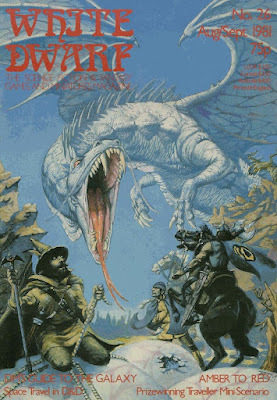White Dwarf: Issue #26
 Issue #26 of White Dwarf (August/September 1981) features a cover by Ian McCaig, an artist well known for his contributions to movies and album covers. Ian Livingstone's editorial floats the idea of the White Dwarf's becoming a monthly periodical but also expresses concern that doing so might affect its overall quality. To ensure this doesn't happen, he needs more regular contributors, particularly for games like D&D, Traveller, and RuneQuest (three games I strongly associate with WD, particularly the latter two). It will be interesting, from a historical point of view, to see how soon his call for new writers has any effect on the magazine's content.
Issue #26 of White Dwarf (August/September 1981) features a cover by Ian McCaig, an artist well known for his contributions to movies and album covers. Ian Livingstone's editorial floats the idea of the White Dwarf's becoming a monthly periodical but also expresses concern that doing so might affect its overall quality. To ensure this doesn't happen, he needs more regular contributors, particularly for games like D&D, Traveller, and RuneQuest (three games I strongly associate with WD, particularly the latter two). It will be interesting, from a historical point of view, to see how soon his call for new writers has any effect on the magazine's content.
The issue kicks off with a remarkable article by Marcus L. Rowland entitled "The DM's Guide to the Galaxy." Subtitled "Space Travel in D&D," Rowland sketches out the broad outline of what space travel might look like in Dungeons & Dragons, drawing on existing rules for inspiration and insights into the nature of space in a universe where magic works. Having long been a fan of the concept of fantasy space travel, this article pleased me, though I wish it had been longer and more fully fleshed out.
"Open Box" tackles four new game products, starting with Games Workshop's own Apocalypse, a game previously entitled The Warlord, which involves the struggle between small empires in post-apocalyptic Europe. The reviewer gives the game a 9 out of 10, which may well be justified, but the fact that the review appears in a Games Workshop periodical makes me question his objectivity. Also reviewed are High Guard for Traveller (also 9 out of 10), Expedition to the Barrier Peaks (9 out of 10), and Knights of Camelot (a mere 7 out of 10).
Part II of Roger Musson's "The Dungeon Architect" focuses on the architectural features of a dungeon, starting with often forgotten elements like verticality and transit. Musson makes the very good point that dungeons exist in three dimensions; yet, many referees fail to take into account height and depth. Likewise, he draws attention to rapid means of getting in and out of the dungeon, such as teleport systems and the like. I find such considerations fascinating, since they're clearly reflective of an earlier, megadungeon-centric style of play that had already begun to fade by the time I entered the hobby. The logistics of a dungeon "expedition" were much less onerous in my youth, so it's good to be reminded of the way things were played before me. Musson rounds out the article with an examination of what he calls "vindictive" features, such as traps, one-way doors, etc.
"Jump Drive Problems" is a collection of short submissions on this topic for use with Traveller. They're a follow-up to the original article on this subject, which appeared in issue #24. Meanwhile, "Lizard Men as Player Characters" by Roger E. Moore and Michael Brown is exactly what its title suggests: providing guidelines for making this reptilian race available for players of AD&D (and even references Quag Keep in support of the idea). "Amber to Red" by Neil Cheyne is a Traveller scenario, the winner of a competition sponsored by the magazine. The scenario involves the hijacking of a starship, with the players taking the roles either of the hijackers or the defenders. It's a perfectly serviceable adventure, complete with starship deckplans, but nothing special in my opinion.
Part IV of Lewis Pulsipher's "An Introduction to Dungeons & Dragons" turns its attention to fighters and thieves. Pulsipher has a lot more to say about the latter than the former. He stresses the flexibility of the thief class and its many potential roles in a party. Frontline fighting, however, is not one of them and repeatedly emphasizes the need to "think thievishly" when playing the class – good advice. "Treasure Chest" continues to offer a grab-bag of new magic items, like the potion of quiet spell casting (which eliminates the need for a verbal component when imbibed) and the assassin's toolkit (filled with all manner of nasty aids to murder). Finally, "Fiend Factory" presents a collection of new humanoid monsters, like shadow goblins and winter kobolds. It's not the column's best installment, though its inclusion of proposed collective nouns for D&D monsters is fun (a confusion of umber hulks, a heard of ear seekers, and a fraction of halflings being some of the best ones).
Issue #26 is a solid, workmanlike effort – nothing special but nevertheless filled with entertaining and occasionally thought-provoking material. As I keep saying in these posts, White Dwarf is inching ever closer to resembling the magazine I remember from my youth (which isn't surprising, since my first issue was #32). It's a worthy alternative to Dragon, both in terms of its focus and, more importantly, perspective.
James Maliszewski's Blog
- James Maliszewski's profile
- 3 followers



